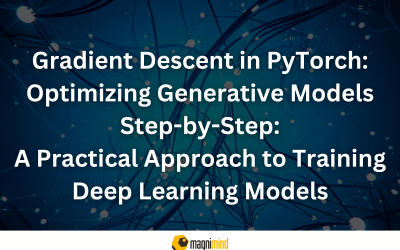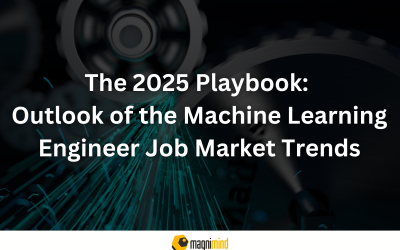The demand for (MLEs) continues to grow in 2024, driven by advancements in generative AI, automation, and real-time analytics. Companies acrossincluding finance, healthcare, e-commerce, and big tech are aggressively hiring MLEs to develop scalable AI solutions. However, the Machine Learning Interview process has become increasingly challenging and competitive, requiring candidates to demonstrate both theoretical knowledge and hands-on skills. A significant trend in 2024 is the rise of AI-driven hiring processes, where candidates are assessed through automated coding challenges, real-world ML case studies, and system design interviews. Additionally, companies are focusing on MLOps skills, deployment strategies, and production-ready ML models, making it essential for MLEs to stay updated with industry best practices. This guide provides a comprehensive breakdown of key topics to help you succeed in MLE interviews. We will cover:
- Core ML concepts, algorithms, and deep learning techniques
- Python coding and system design questions
- MLOps and model deployment strategies
- Behavioral interview techniques and soft skills
- Top ML interview questions with sample answers
Machine Learning Interview Trends in 2024
The demand for Machine Learning Engineers (MLEs) has surged in finance, healthcare, e-commerce, and generative AI, as companies seek to develop AI-driven automation, fraud detection systems, personalized recommendations, and large-scale analytics. With AI adoption accelerating, businesses require MLEs who can build scalable, production-ready ML solutions rather than just theoretical models. Companies are moving away from traditional whiteboard-style interviews and favoring real-world coding challenges. Instead of solving abstract algorithmic problems, candidates are often given take-home projects to assess their ability to build practical solutions—similar to how platforms like elmst-casinos.com are evaluated not just on design, but on the functionality, reliability, and scalability of their gaming and user data systems.
- Clean and preprocess data
- Train, evaluate, and optimize ML models
- Write efficient, production-quality Python code
- Increased Focus on LLMs & MLOps
With the rise of generative AI and large language models (LLMs) such as Bard, ChatGPT and many companies now test candidates on LLM fine-tuning, prompt engineering, and model deployment. Similarly, MLOps skills such as model monitoring, CI/CD pipelines, and cloud-based ML deployment have become must-haves rather than optional skills. Employers are placing greater emphasis on a candidate’s ability to communicate technical concepts, collaborate with cross-functional teams, and handle project challenges. Behavioral rounds often include problem-solving case studies, where candidates must explain how they would debug a failing ML model, handle biased data, or scale an AI system. To excel in Machine Learning Engineer (MLE) interviews, candidates must have a strong foundation in machine learning theory, deep learning techniques, and applied mathematics. This section covers the core concepts that are frequently tested in technical interviews.
Core Machine Learning Concepts
Supervised vs. Unsupervised Learning
- Supervised Learning: In supervised learning, labeled data is used to train the models (e.g., classification, regression). Spam detection in emails is an example of supervised learning.
- Unsupervised Learning: In unsupervised learning, unlabeled data is used to identify patterns (e.g., clustering, anomaly detection). Customer segmentation in marketing is an example of unsupervised learning.
Overfitting & Underfitting
- Overfitting: The model learns too much detail from training data, leading to poor generalization.
- Underfitting: The model is too simple, failing to capture essential patterns.
- Solution: Use regularization (L1/L2), cross-validation, and early stopping.
Feature Engineering & Selection
- Feature Engineering: Creating meaningful input features (e.g., extracting text embeddings for NLP).
- Feature Selection: Removing redundant or irrelevant features (e.g., using PCA or mutual information).
Deep Learning Essentials
Neural Networks (CNNs, RNNs, Transformers)
- CNNs (Convolutional Neural Networks): Used in image processing tasks (e.g., facial recognition).
- RNNs (Recurrent Neural Networks): Used for sequential data (e.g., speech recognition).
- Transformers: Powering modern NLP models like GPT and BERT.
Transfer Learning & Fine-Tuning
- It means using the pre trained models such as BERT and ResNet and then fine tuning them to implement on new tasks can save the training time and enhances performance.
Applied Mathematics & Statistics
Probability Distributions & Bayes Theorem
- Understanding Gaussian, Poisson, and Bernoulli distributions is key for ML modeling.
- Bayes Theorem is fundamental for Naïve Bayes classifiers and Bayesian optimization.
Linear Algebra for ML (Matrices, Eigenvalues)
- ML models rely on matrix operations for transformations (e.g., PCA for dimensionality reduction).
- Eigenvalues & eigenvectors help in understanding variance in datasets.
Optimization Techniques (Gradient Descent, Adam, SGD)
- Gradient Descent: The backbone of training ML models.
- Adam & SGD: Adaptive optimizers to enhance convergence speed and model performance.
Key Machine Learning Algorithms
Understanding and effectively explaining ML algorithms is crucial for MLE interviews. Interviewers often ask candidates to describe algorithms, their use cases, and trade-offs. Below are the key machine learning algorithms that every MLE should master.
Regression Models
Linear Regression
- Use Case: Predicting continuous values (e.g., house prices).
- Explanation: Fits a straight line, modeling the relationship between input variables and output.
- Limitation: Sensitive to outliers, assumes linear relationships.
Logistic Regression
- Use Case: Binary classification (e.g., spam detection).
- Explanation: Uses the sigmoid function to map output between 0 and 1.
- Limitation: Assumes linear decision boundaries.
Ridge & Lasso Regression
- Use Case: Avoiding overfitting in linear models.
- Ridge Regression: Adds L2 regularization (penalizes large coefficients).
- Lasso Regression: Adds L1 regularization (shrinks coefficients to zero, useful for feature selection).
Tree-Based Models
Decision Trees
- Use Case: Interpretable models for classification & regression.
- Explanation: Splits data based on feature values, forming a tree-like structure.
- Limitation: Prone to overfitting.
Random Forest
- Use Case: Robust classification & regression.
- Explanation: Uses multiple decision trees and averages their outputs for better generalization.
- Advantage: Reduces overfitting compared to a single decision tree.
XGBoost (Extreme Gradient Boosting)
- Use Case: High-performance ML competitions, tabular data.
- Explanation: A boosting algorithm that builds trees sequentially, correcting previous errors.
- Advantage: Handles missing values, highly optimized.
Clustering Algorithms
K-Means Clustering
- Use Case: Customer segmentation, anomaly detection.
- Explanation: It divides the data into clusters according to distance from cluster centroids.
- Limitation: Requires choosing K, sensitive to outliers.
DBSCAN (Density-Based Spatial Clustering of Applications with Noise)
- Use Case: It helps to identify the clusters from non-uniform data such as fraud detection.
- Explanation: Groups dense areas and marks sparse areas as noise.
- Advantage: No need to predefine K, works well with outliers.
Dimensionality Reduction
Principal Component Analysis (PCA)
- Use Case: Reducing features while retaining variance (e.g., image compression).
- Explanation: Converts data into a set of orthogonal components.
- Advantage: Speeds up ML models, removes redundancies.
t-SNE (t-Distributed Stochastic Neighbor Embedding)
- Use Case: Data visualization in 2D or 3D.
- Explanation: Preserves local structure in high-dimensional data.
- Limitation: Computationally expensive, not ideal for clustering.
Reinforcement Learning Basics
Reinforcement Learning (RL)
- Use Case: Robotics, gaming, recommendation systems.
- Explanation: Agents learn by interacting with an environment, receiving rewards for optimal actions.
- Key Concepts:
- State: The current situation of the agent.
- Action: Possible decisions the agent can make.
- Reward: Feedback based on the action taken.
- Q-Learning: A popular RL algorithm that learns optimal policies.
Hands-on Coding & System Design Questions
In MLE interviews, candidates are expected to demonstrate strong coding skills and system design expertise. This section covers key areas, including Python programming, ML libraries, and scalable ML pipeline design.
Python & ML Libraries
A Machine Learning Engineer must be proficient in Python and ML-focused libraries such as:
- Pandas: Used for data manipulation, preprocessing, and analysis.
- NumPy: Essential for numerical computing, array operations, and matrix manipulations.
- Scikit-Learn: Provides ML models, feature selection, hyperparameter tuning, and evaluation metrics.
- TensorFlow & PyTorch: Used for deep learning model building, training, and optimization.
Writing Clean & Efficient ML Code
Common interview tasks include:
- Data preprocessing: Handling missing values, feature scaling, and one-hot encoding.
- Efficient vectorized operations: Using NumPy and Pandas instead of loops.
- Model implementation: Training ML models with Scikit-Learn, TensorFlow, or PyTorch.
- Optimizing ML pipelines: Using caching, multiprocessing, or distributed computing (e.g., Dask, Spark).
System Design for MLE Interviews
MLE candidates must explain and design scalable ML systems. Interviewers assess:
How to handle large datasets efficiently?
- Optimizing model inference for real-time applications
- Scalable deployment strategies
How to Design a Scalable ML Pipeline?
A typical end-to-end ML pipeline includes:
- Data Collection & Ingestion: Streaming data via Kafka, Apache Spark.
- Preprocessing & Feature Engineering: Batch processing with Pandas/Dask.
- Model Training & Optimization: Using TensorFlow/PyTorch with distributed training.
- Model Deployment & Monitoring: Serving models via FastAPI, Flask, or TensorFlow Serving.
- Continuous Integration & Deployment (CI/CD): Automating retraining with MLOps tools.
System Design Question
“Design an ML pipeline for a real-time fraud detection system.”
Answer Framework:
- Data Source: Streaming transactions from a database or event-based system.
- Feature Engineering: Extracting transaction patterns, user behavior insights.
- Model Choice: Online learning models or ensemble methods (Random Forest, XGBoost).
- Deployment Strategy: Use Kubernetes & Docker for scalable microservices.
Deploying Models Using Docker, Kubernetes, and CI/CD
Modern ML deployments rely on containerization and orchestration:
- Docker: Packages ML models into portable containers.
- Kubernetes: Manages scalable deployments in cloud environments.
- CI/CD Pipelines: Automates testing and deployment using GitHub Actions, Jenkins, or AWS SageMaker Pipelines.
Model Versioning & Experiment Tracking (MLflow, DVC)
Why Versioning Matters?
ML models evolve over time due to:
- New training data
- Hyperparameter tuning
- Different architectures
Tools for Model Versioning & Experiment Tracking
- MLflow: Tracks experiments, logs parameters, and manages model versions.
- DVC (Data Version Control): Handles large datasets and model versions with Git-like commands.
Monitoring ML Models in Production
Once deployed, models must be monitored for:
Data Drift: Changes in data distribution affect model performance.
Concept Drift: The relationship between input & output changes over time.
Latency & Performance: Ensuring real-time models respond efficiently.
Tools for ML Monitoring
Prometheus + Grafana: Monitor system metrics & performance.
Evidently AI: Detects data drift and model degradation.
Scaling ML Models (Batch vs. Real-Time Inference)
Batch Inference
- Used for offline predictions (e.g., recommendation systems, churn prediction).
- Efficient for large datasets but not real-time.
- Common tools: Apache Spark, Airflow, AWS Batch.
Real-Time Inference
- Used for fraud detection, chatbots, recommendation engines.
- Requires low latency & high availability.
- Common tools: FastAPI, TensorFlow Serving, NVIDIA Triton.
Choosing the Right Strategy:
| Factor | Batch Inference | Real-Time Inference |
| Latency | High | Low |
| Computational Cost | Lower | Higher |
| Use Case | Analytics, periodic reports | Fraud detection, chatbots |
Explaining Complex ML Topics to Non-Technical Stakeholders
MLEs often collaborate with business teams, executives, and domain experts. The ability to simplify ML concepts is crucial.
How to simplify ML explanations?
- Use analogies: A decision tree works like a series of yes/no questions, similar to a game of 20 Questions.
- Relate to business impact: This model predicts customer churn, helping us retain high-value users.
- Avoid technical jargon: Instead of Gradient boosting minimizes residual errors, say This model learns from past mistakes to improve predictions.
Handling Failure Scenarios in ML Projects
Interviewers assess how candidates handle failure and setbacks in ML projects.
Common ML failure scenarios:
- Data pipeline failures: Data inconsistencies, missing values, bias.
- Model underperformance: Poor generalization, concept drift, overfitting.
- Deployment issues: Latency problems, unexpected real-world behavior.
Example Question: Tell me about a time an ML project failed and what you did to fix it.
Response Framework:
- Explain the issue (E.g., The deployed fraud detection model flagged too many legitimate transactions).
- Analyze the root cause (E.g., Model trained on outdated data, leading to drift).
- Action taken (E.g., Introduced retraining pipeline, added recent transaction data).
- Outcome & Lesson learned (E.g., Reduced false positives, implemented continuous monitoring).
Top ML Interview Questions & Sample Answers
Interviewers assess technical knowledge, coding skills, and problem-solving abilities. Here are some common ML interview questions with sample answers to help you prepare effectively.
Technical Questions
Q1: Explain Random Forest and how it works.
Answer: Random Forest is a learning algorithm that combines multiple decision trees to improve accuracy and reduce overfitting.
- It uses bagging (Bootstrap Aggregating) to train each tree on a random subset of the data.
- The final prediction is made using majority voting (classification) or averaging (regression).
Follow-up: How does Random Forest handle missing data?
It uses proximity-based imputation, where missing values are replaced with the most common values from similar data points.
Q2: What is Gradient Boosting, and how is it different from Random Forest?
Answer: Gradient Boosting is an ensemble technique that constructs trees sequentially, with each new tree correcting the errors of its predecessors. Unlike Random Forest, which trains trees independently, Gradient Boosting leverages gradient descent to enhance performance.
- Popular Implementations: XGBoost, LightGBM, CatBoost.
- Key Difference: Random Forest reduces variance, while Gradient Boosting reduces bias.
Follow-up: How do you prevent Gradient Boosting from overfitting?
Use regularization (L1/L2), early stopping, and learning rate decay.
Case Studies: Handling Biased Data
Q3: How would you improve an ML model trained on biased data?
Scenario: Your hiring prediction model favors male candidates over females. How do you fix it?
Approach:
- Identify Bias: Check if training data has an unequal gender distribution.
- Balance Data: Use resampling techniques (oversampling, undersampling).
- Debias Features: Remove or re-weight biased variables (e.g., gender-related words in resumes).
- Fairness Metrics: Evaluate equalized odds, disparate impact to ensure fairness.
Follow-up: What if resampling doesn’t work?
Use adversarial debiasing (train a model to predict bias and remove it).
Conclusion
Preparing for a Machine Learning Engineer (MLE) interview in 2024 requires a strategic approach, combining technical expertise, coding proficiency, system design knowledge, and strong communication skills. Mastering machine learning fundamentals, including key algorithms, deep learning architectures, and applied mathematics, forms the foundation of a successful preparation strategy. Hands-on practice with coding problems on Leetcode, Kaggle, and Hugging Face is essential, along with gaining experience in scalable ML pipeline design, MLOps, and model deployment. Additionally, developing soft skills, such as effectively explaining ML concepts to non-technical stakeholders and handling behavioral questions using the STAR method, can significantly impact interview performance.
To maximize success, aspiring MLEs should stay updated with emerging trends like LLMs, generative AI, and real-time model scaling, and actively participate in mock interviews and peer discussions. Rather than relying solely on memorization, candidates should focus on understanding concepts and applying them to real-world scenarios. Lastly, maintaining a growth mindset and embracing challenges as learning opportunities will help build confidence and adaptability. With regular practice, structured preparation, and determination, you’ll be well-prepared to succeed in MLE interviews and land a fulfilling career in 2024!



